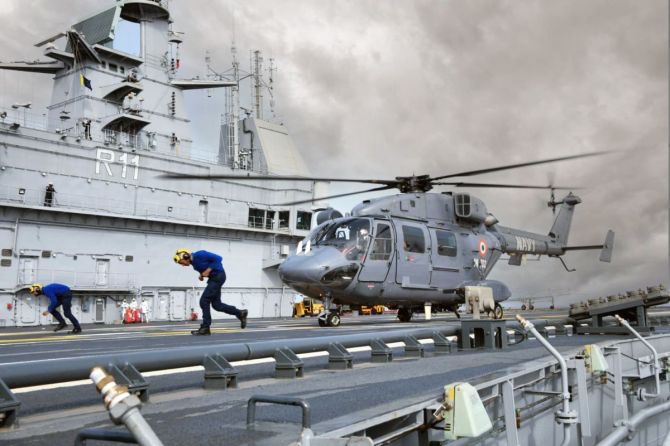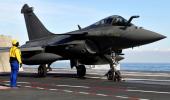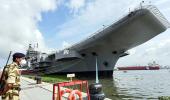The navy is pushing hard for IAC-2 to be a 65,000-tonne, flat deck carrier that is designed and built in India, with technical and tactical consultation from the US navy -- the global masters in aircraft carrier operations.

Recently, when Cochin Shipyard Ltd handed over Indian Naval Ship Vikrant to the Indian Navy, the shipyard was left with a large empty berth where India's first indigenous aircraft carrier, or IAC-1, had been under construction.
Now, demanding answers were two questions: First, is there going to be a second indigenous carrier? And, if yes, what would be the size and specifications of IAC-2?
The navy’s answers to those questions will determine India’s naval power for decades to come.
In addressing these issues, the navy must remember two simple truths: First, an aircraft carrier exists to take its air wing into battle. And second, the types of aircraft in a carrier's air wing and the efficiency with which they can be sustained in battle is the ultimate determinant of a carrier's worth.
By both these measures, the Indian Navy has fallen short.
Its carriers have not generated the air power needed to justify the enormous expense of a carrier battle group -- which includes the cost of the carrier itself, its air wing and the destroyers, frigates, corvettes and submarines that form a self-sufficient 'carrier battle group' needed to establish 'sea control' over oceanic spaces that are hundreds, even thousands, of nautical miles away from our shores.
Since Independence, India has cumulatively operated three aircraft carriers. The second INS Vikrant, which will be commissioned soon, will be the fourth.
Two of these, the original INS Vikrant (19,000 tonnes) and the INS Viraat (28,000 tonnes), have been decommissioned, leaving the navy with only one serving carrier: The 44,000-tonne INS Vikramaditya.
When the resurrected INS Vikrant joins the fleet later this month, the 45,000-tonne carrier will be the second serviceable carrier.
As a rough approximation, an aircraft carrier can embark one aircraft for every 1,000 tonnes of displacement. That means that neither the earlier Vikrant, nor the Viraat, were able to embark more than a squadron of fighters (16-18 aircraft), along with the 4-5 helicopters needed for fleet tasks, such as anti-submarine warfare (ASW) and airborne early warning and control (AEWC).
Even the INS Vikramaditya cannot embark more than about 25 fighters, which leaves it short of air power in crucial battle spaces and missions.
That is why the navy is pushing hard for IAC-2 to be a 65,000-tonne, flat deck carrier that is designed and built in India, with technical and tactical consultation from the US navy -- the global masters in aircraft carrier operations.
For this, the two countries have constituted a Joint Working Group on aircraft carrier technology cooperation under the Defence Technology and Trade Initiative.
If this carrier comes to pass, it will embark some 55 fixed-wing fighters, ASW and utility helicopters and -- in a first for the Indian Navy -- aircraft like the fixed-wing, radome-equipped E2C Hawkeye for extended maritime domain awareness (MDA) missions.
Such aircraft are critical for establishing sea control, and a flat deck carrier with a catapult launch facility is essential for launching them.
The MiG-29K that India ordered for INS Vikramaditya and IAC-1 has been a poor choice, being unable to absorb the pounding that carrier-based fighters receive while landing, when the pilot slams down his fighter at a precise spot on the deck so that it can engage a row of arrestor wires that drag the aircraft to a halt.
However, after buying 45 MiG-29K/KUBs from Russia, naval acquisition managers have sent out a Request for Information for 26 MRCBF (multi-role carrier-borne fighters).
Evidently, only two aircraft meet the specifications: The marine version of Dassault's Rafale fighter; and Boeing's F/A-18E/F Super Hornet, the US navy's workhorse that flies from all 11 of its carriers. The Super Hornet is the better choice, as is evident from the plethora of disadvantages in buying its rival, the Rafale-Marine.
First, the Rafale-Marine does not come in a twin-seat version. The Indian Navy, which has specified that it requires eight twin-seat and 18 single-seat fighters, would only get that configuration in the Super Hornet.
If, on the other hand, the navy were to buy 26 Rafale-Marine fighters, the eight twin-seaters would be available for training ashore, or for combat missions flown from ashore, but not for combat missions flown from the carrier deck.
The IAF might conceivably use the French fighters in combat, but only from on-shore bases.
On the other hand, if Super Hornets were to be bought, they would all -- single-seat as well as twin-seat versions -- fly combat missions from the carrier, ensuring better use of our limited budget.
Second, flying the Super Hornet would ensure high interoperability between the fighters, the aircraft carrier and a number of other platforms that the Indian military has bought, or could do so.
They include the E/A-18G Growler, a highly specialised electronic warfare (EW) aircraft that accompanies the Super Hornets on missions, blinding enemy radar and thus enhancing survivability -- a tandem capability that no other carrier-borne fighter in the world enjoys. The US government has not yet agreed to supply India the Growler, but is likely to do so in the future.
But if the Indian Navy does not buy the Super Hornet now, they would effectively be closing the door on Growlers for ever.
Third, the interoperable platforms also include MH-60R Seahawk helicopters, the P-8I multi-mission maritime aircraft and the MQ-25 Stingray autonomous, carrier-borne tankers. If the Indian Navy does not buy the Super Hornet now, it may also be denying itself access to MQ-25 tankers from US carriers in the future.
The MQ-25, today a carrier-borne tanker, is likely to be modified for additional roles in the future. The Indian Navy has big ambitions at sea in the autonomous domains, including air. The Super Hornet could open the doors for this, if the US grants access to the MQ-25 some day, as US-India relations flower.
Fourth, the US Navy might also link the availability of EMALS/AAG from General Atomics for the next indigenous aircraft carrier (IAC-2) to the strategic closeness that a sale of Super Hornets would bring.
Fifth, a Super Hornet sale to India would create a higher degree of interoperability with US naval forces in the Indo-Pacific, as well as with the Quad militaries (both Australia and the US operate Hornets).
Sixth, the acquisition of Super Hornets would allow the Indian Navy continued access to the most capable combat aviation assets in the Indo-Pacific (the US has 11 carriers against only one French and one British carrier).
The US navy has employed aircraft carriers effectively for a century and working with them would help the Indian Navy absorb the best practices at sea.
Some 700+ Hornets have accumulated over a million arrestments at sea, against France's far lesser experience of flying 40-plus Rafale-Marines from a single aircraft carrier for 20-odd years.
In fact, endorsement is best provided by the French navy that sends its pilots to the US to learn the art of tail-hooking.
Finally, working with the US would help the Defence R&D Organisation learn global best practices in carrier operations as they design and develop the 'twin-engine deck-based fighter'.












 © 2025
© 2025